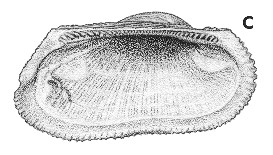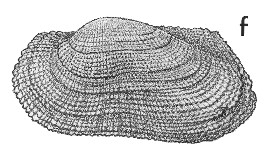
Revised descriptions of New Zealand Cenozoic Mollusca from Beu and Maxwell (1990)

 | Revised descriptions of New Zealand Cenozoic Mollusca from Beu and Maxwell (1990) | 
|
  (Pl. 44c): Te Piki, Cape Runaway, near East Cape, Haweran (Oxygen isotope stage 7; GNS, from an early collection) |
  (Pl. 44f): Te Piki, Cape Runaway, near East Cape, Haweran (Oxygen isotope stage 7; GNS, from an early collection) |
Beu & Maxwell (1990): Chapter 16; p. 334; pl. 44 c,f.
Synonymy: Arca decussata (not of Sowerby) of Suter 1913c, p. 848; Arca (Barbatia) novae-zelandiae E. A. Smith 1915, p. 88
Classification: Arcidae: Arcinae
Description: Moderate-sized for family (to 75 mm long), elongate, weakly inflated, with low umbones and subparallel dorsal and ventral margins; anterior margin rounded, posterior margin weakly subrectangular, in most specimens weakly inclined backward towards venter. Sculpture of many low, narrow, closely spaced radial costae, raised into many small, scaly nodules where crossed by many low, narrow, commarginal ridges. Hinge long, straight, narrow, with many similar teeth; teeth are short ridges, vertical in centre of hinge but radially diverging at ends. Ligamental area between umbo and hinge narrow, with a few prominent ligamental grooves. Interior of ventral margin finely denticulate except around shallow, smooth, byssal gape that occupies central 0.2-0.3 of shell length. Pallial line simple; interior finely striate inside pallial line, except for small, subcircular, roughly equal anterior and posterior adductor scars.
Comparison: Barbatia awamoana (Altonian) differs from B. novaezelandiae only in its slightly more elongate shape and more rounded posterior end; but similar specimens are virtually unknown from Middle Miocene to early Pliocene rocks.
Distribution: Waipipian-Recent; Recent, New Zealand (type). Not uncommon in many Pliocene and Pleistocene shellbeds — Waipipi Shellbeds, Waverley Beach, west of Wanganui; particularly common in Tainui Shellbed, Castlecliff; common in some Haweran terrace faunules and at Te Piki, near East Cape. Common today byssally attached in crevices and under boulders, at and below low tide on exposed rocky shores, and attached to hard substrates (boulders, shells) dredged on the shelf, down to about 200 m. Consequently, most Pliocene and Pleistocene localities where B. novaezelandiae occurs are in shallow-water, high-energy facies. Tainui Shellbed, Castlecliff (Castlecliffian), where it is particularly common, is a shellbed formed by bypassing of fine sediment in a current-swept mid-shelf environment (oysters, brachiopods, carnivorous epifaunal gastropods, and epifaunal, byssally attached bivalves such as Modiolus aerolatus, Limaria orientalis, and Talochlamys gemmulata are also common). This shellbed also provides the only fossil locality for 2 distinctive gastropods, Ponderia zealandica (Pl. 48i) and Stephopoma roseum (Quoy & Gaimard, 1834).
Cite this publication as: "A.G. Beu and J.I. Raine (2009). Revised
descriptions of New Zealand Cenozoic Mollusca from Beu and Maxwell (1990). GNS
Science miscellaneous series no. 27."
© GNS Science, 2009
ISBN
978-0-478-19705-1
ISSN 1177-2441
(Included with a PDF facsimile file
copy of New Zealand Geological Survey Paleontological Bulletin 58 in CD version
from: Publications Officer, GNS Science, P.O. Box 30368 Lower Hutt, New
Zealand)